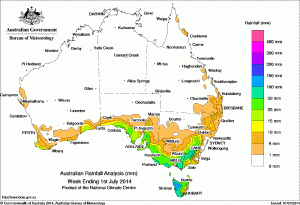For the week ending 1 July 2014, rainfall was recorded along the southern coast and in Victoria, Tasmania, southern and eastern New South Wales.
At the start of the week, a deep low pressure system and strong cold front moved through Bass Strait and produced snow about the southern ranges of New South Wales and the Victorian Alps along with moderate rainfall totals in southern Victoria and western Tasmania.
Another complex low pressure system and active cold front traversed the Southern Ocean mid-week. As the vigorous frontal system moved eastwards across the Great Australian Bight, it extended into South Australia, Victoria, inland New South Wales and southern Queensland with the heaviest rainfall associated with the low pressure systems passing south of Tasmania and through Bass Strait. More snow fell in elevated areas of the southern New South Wales and Victorian Alps and widespread, moderate rainfall was recorded in southern Victoria and western Tasmania.
Light rainfall associated with a surface trough was recorded over southeastern Australia at the end of the week.
The highest weekly rainfall total of 203 mm was recorded at Falls Creek in the Victorian Alpine region. Falls in excess of 100 mm were recorded in the west coast of Tasmania, in pockets of elevated New South Wales, northeastern Victoria and in the Otway Ranges.
Rainfall totals between 50 mm and 100 mm were recorded along the coastal fringe of South Australia, through southern and central Victoria and the Snowy Mountains area of New South Wales, and in most of western and northeastern Tasmania.
Rainfall totals between 15 mm and 50 mm were recorded along parts of the southern coast of Western Australia, a large part of coastal South Australia, much of Victoria extending into southeastern New South Wales west of the Great Dividing Range and the remaining eastern parts of Tasmania.
Isolated totals exceeding 10 mm were recorded in southeastern Queensland, northeastern New South Wales as well as in the central and southern New South Wales tablelands, East Gippsland and northwestern Victoria, southern South Australia and isolated pockets of the south coast of Western Australia.
The Northern Territory, most of Queensland, inland New South Wales, northern South Australia, and Western Australia away from the south coast recorded little or no rainfall.
| State | Highest | 2nd Highest | 3rd Highest |
|---|---|---|---|
| WA | Cowaramup (32 mm) (South Coast) |
Eyre (23 mm) (Eucla) |
Margaret River (22 mm) (South Coast) |
| NT | No rainfall recorded | ||
| SA | Lenswood Research Centre (117 mm) (East Central) |
Beachport (69 mm) (Lower Southeast) |
Millicent (68 mm) (Lower Southeast) |
| Qld | Ballandean Post Office (21 mm) (East Darling Downs) |
Lanark (14 mm) (Moreton) |
Applethorpe (14 mm) (East Darling Downs) |
| NSW/ACT | Perisher Valley (194 mm) (Snowy Mountains) |
Batlow Post Office (133 mm) (Southwest Slopes) |
Argalong (Sandy Creek) (128 mm) (Southwest Slopes) |
| Vic | Falls Creek (Rocky Valley) (203 mm) (Upper Northeast) |
Haines Junction (170 mm) (West Coast) |
Wyelangta (160 mm) (West Coast) |
| Tas | Lake Margaret (132 mm) (West Coast) |
Queenstown (South Queenstown) (121 mm) (West Coast) |
Waratah (Mount Road) (114 mm) (West Coast) |
Source: Bureau of Meteorology

